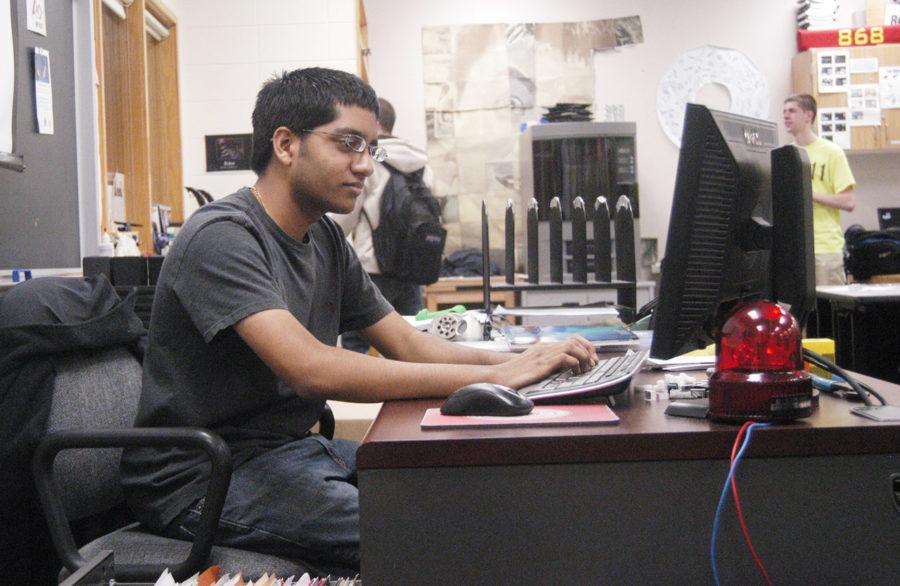As the TechHOUNDS robotics team completes its pre-season, confidence and anxiety carries into the upcoming six-week build season, according to club sponsor George Giltner.

The build season will begin with a kick-off on Jan. 7 at IUPUI to reveal the game.
“They’ll also give us a kit of parts, which will contain the motors we can use, the brain of the robot, which is the control system and various other small parts that we’re allowed to use on the robot,” Giltner said.
The team schedule will get busier during the pre-season, with practices from 6 to 9 p.m. every Monday, Wednesday and Friday, and practices after-school until 6:30 p.m. on Tuesdays and Thursdays. Giltner said the team may schedule Saturday practices if it needs extra time.
“The first week we usually brainstorm and come up with a design of how we’re going to build the robot. Week two and three is typically prototyping. Four, five and six are usually dedicated to the construction of the actual robot,” Giltner said. “I usually have a goal to be done with the robot by the fifth week so we have a week to play with the completed robot and see what things might break and what might not work so we have some time to fix it.”
Both Gitlner and Ryan Wilmes, student team leader and senior, said they believe this year’s build season will differ from those in the past.
“We’ve had problems last year where we didn’t get the entire robot designed out before it came together, so we had a problem at the end of the season where not all the parts worked together perfectly,” Wilmes said. “What we’re hoping to do this year is to get everything designed out before we start building so we’ll have an edge when it comes to the build season.”
According to Giltner, one added advantage this year is the team’s preparation during the pre-season in building three drive trains.
“Since we already have three (drive trains) to choose from, if the game dictates that we can use one of those three, then we already have a design ready to go,” Giltner said. “That’s going to definitely save a week that, in years past, like last year, almost lasted two weeks because we created a very complicated drive train.”
In addition, since the team has twenty seniors, most of whom are four-year members, Giltner said he is somewhat relieved. A worry stems from programming/electrical and robot ops divisions, since each is dominated by a small number of senior members while the rest are first-years.
“With programming, it’s such a skill that you can’t teach in the six weeks of the build season. They have to either come to the table with a lot of prior knowledge or do a lot of research on the language we use, which is Java,” Giltner said. “That’s something I think I’m definitely worrying about.”
During the post-season, competition regulations allow TechHOUNDS to build small components to add to the robot, such as an arm or some deployment device. The limit is ten pounds of material, and Giltner said the team may look into working like this following build season.
As for build season, both Giltner and Wilmes echoed high hopes.
“With the pre-season, I think that’s really prepared us. I think we’ve done a lot to prepare for the season where in years past we haven’t used the pre-season as effectively as we have this year,” Giltner said. “I’m kind of excited to see what happens with our preparation.”

































![AI in films like "The Brutalist" is convenient, but shouldn’t take priority [opinion]](https://hilite.org/wp-content/uploads/2025/02/catherine-cover-1200x471.jpg)









































![Review: “The Immortal Soul Salvage Yard:” A criminally underrated poetry collection [MUSE]](https://hilite.org/wp-content/uploads/2025/03/71cju6TvqmL._AC_UF10001000_QL80_.jpg)
![Review: "Dog Man" is Unapologetically Chaotic [MUSE]](https://hilite.org/wp-content/uploads/2025/03/dogman-1200x700.jpg)
![Review: "Ne Zha 2": The WeChat family reunion I didn’t know I needed [MUSE]](https://hilite.org/wp-content/uploads/2025/03/unnamed-4.png)
![Review in Print: Maripaz Villar brings a delightfully unique style to the world of WEBTOON [MUSE]](https://hilite.org/wp-content/uploads/2023/12/maripazcover-1200x960.jpg)
![Review: “The Sword of Kaigen” is a masterpiece [MUSE]](https://hilite.org/wp-content/uploads/2023/11/Screenshot-2023-11-26-201051.png)
![Review: Gateron Oil Kings, great linear switches, okay price [MUSE]](https://hilite.org/wp-content/uploads/2023/11/Screenshot-2023-11-26-200553.png)
![Review: “A Haunting in Venice” is a significant improvement from other Agatha Christie adaptations [MUSE]](https://hilite.org/wp-content/uploads/2023/11/e7ee2938a6d422669771bce6d8088521.jpg)
![Review: A Thanksgiving story from elementary school, still just as interesting [MUSE]](https://hilite.org/wp-content/uploads/2023/11/Screenshot-2023-11-26-195514-987x1200.png)
![Review: "When I Fly Towards You", cute, uplifting youth drama [MUSE]](https://hilite.org/wp-content/uploads/2023/09/When-I-Fly-Towards-You-Chinese-drama.png)
![Postcards from Muse: Hawaii Travel Diary [MUSE]](https://hilite.org/wp-content/uploads/2023/09/My-project-1-1200x1200.jpg)
![Review: "Ladybug & Cat Noir: The Movie," departure from original show [MUSE]](https://hilite.org/wp-content/uploads/2023/09/Ladybug__Cat_Noir_-_The_Movie_poster.jpg)
![Review in Print: "Hidden Love" is the cute, uplifting drama everyone needs [MUSE]](https://hilite.org/wp-content/uploads/2023/09/hiddenlovecover-e1693597208225-1030x1200.png)
![Review in Print: "Heartstopper" is the heartwarming queer romance we all need [MUSE]](https://hilite.org/wp-content/uploads/2023/08/museheartstoppercover-1200x654.png)




